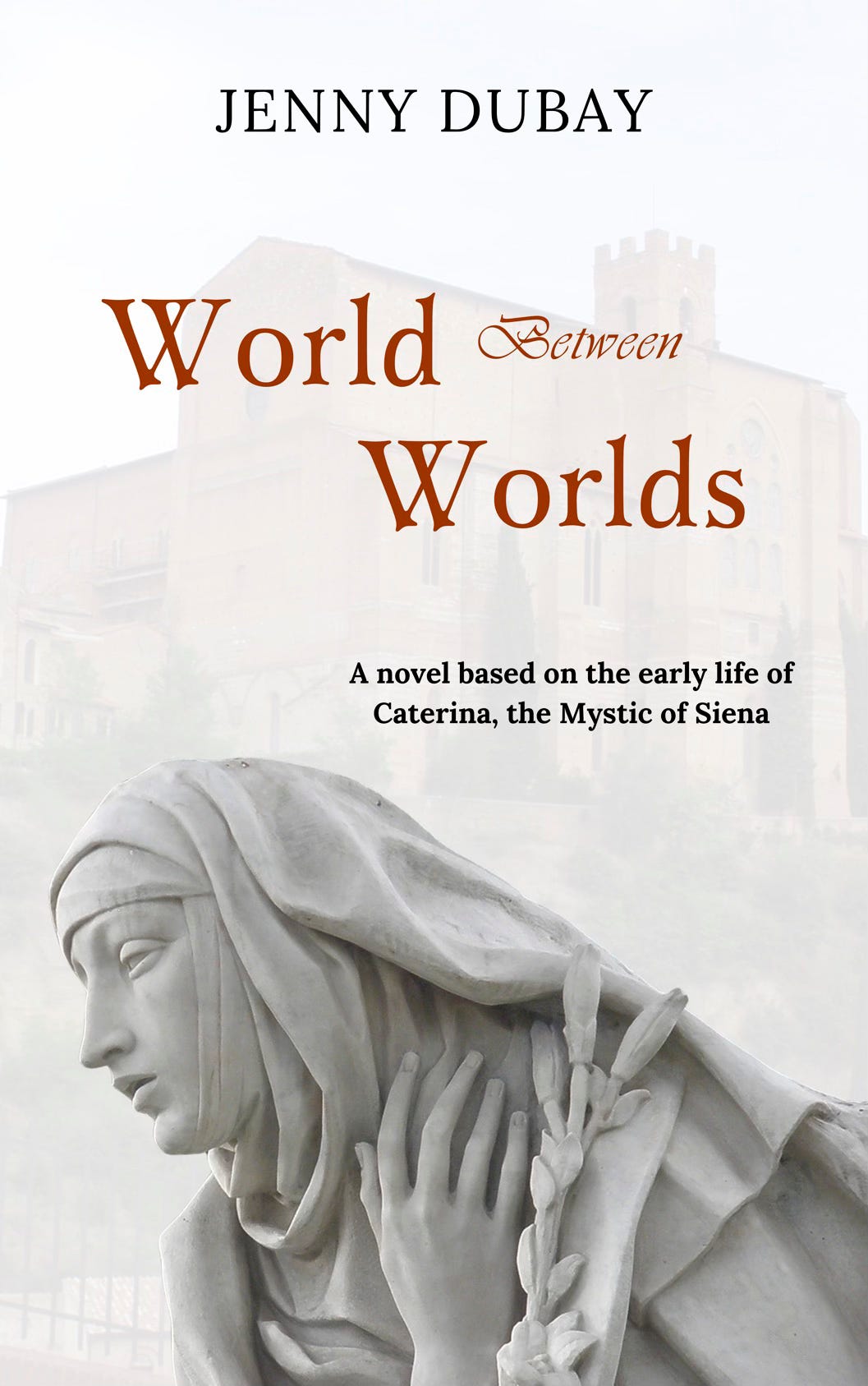Legend Fiction Interview: How Jenny duBay Revives St. Catherine of Siena for Modern Readers
Four years, one novel, & multiple trips to Siena: How one tiny footnote sparked a decade of passion and faith
I recently had the honor of being interviewed by Dominic de Souza on the Legend Fiction Show about my book, World Between Worlds: A Novel Based on the Early Life of Caterina, the Mystic of Siena. It was such a fun, engaging interview in which we discussed how I came to write the book, how to understand St. Caterina through a medieval worldview, and more.
You can watch the video here, and below is Dominic’s commentary on our conversation:
Jenny duBay never set out to write a saint’s life. She just stumbled on a footnote about a strange woman who fasted and convinced a pope to come back to Rome—and something in her lit up. Years later, after research, prayer, and walking Siena’s streets, that spark turned into her first novel, World Between Worlds.
It’s the story of St. Catherine of Siena, told as if you could smell the incense, hear the bells, feel her wrestling with God. Jenny calls it 'bringing the mystics back to life,' because their words don’t come fully alive until you step into their world.
For her, Catherine was the one who dragged her back to the Church. For her readers, Catherine becomes a voice on fire, reminding us that union with God is flesh, blood, and the hard work of surrender.
Follow:
Jenny duBay’s story begins in a dark place.
A survivor of domestic abuse and betrayal trauma, she had walked through what she called her “dark years.” She trained as a certified trauma-informed coach, determined to help other women find a path forward. Suffering, she believed, could either be a dead end or a doorway. She found a way to open the door.
But, even while coaching, fiction remained her first love.
She had been writing stories since childhood, pestering her mother for spelling help at the age of four to finish her first little book. Fiction didn’t always pay the bills, but it kept her heart alive. Coaching gave her freedom, such as her own hours, her own clients, while writing gave her soul the fire to create.
That fire eventually found its fuel in a surprising place: the life of St. Catherine of Siena.
Surprised by Siena
Jenny admitted she hadn’t grown up knowing much about the saints, even though she was raised Catholic. She had drifted away from the church as an adult, but her interest in Christian mysticism lingered.
One day, while reading Barbara Tuchman’s A Distant Mirror, a history of the fourteenth century, a name leapt out at her: a young woman who had persuaded the pope to return to Rome. The reference was brief, but it lit something in Jenny.
“I could physically feel a spark,” she recalled. Who was this woman? Why had she never heard of her? She had to know.
What she discovered was both unsettling and irresistible. Catherine fasted severely, starved herself, and spoke often of blood and ‘vomiting sin.’
At first Jenny thought, this woman sounds strange. But the strangeness pulled her in. Catherine, she realized, was living in a world whose mindset was different to modern readers. To understand her, Jenny would have to inhabit that world.
Into the Medieval Mind
So she did. She spent four years reading, researching, and praying. She wrote her first draft of World Between Worlds nearly a decade ago, but then set it aside. Only later, with fresh conviction and inspiration, did she pull it back out, revise it, and begin to pursue publication.
Along the way she traveled to Siena multiple times, even staying in a hotel built into Catherine’s childhood home. She walked the streets, listened to the cathedral bells roll across the hills, and imagined the girl who had once heard those same bells centuries before.
“It’s in my soul now,” she said. “Because I could put myself there, I could put my readers there.”
The result was a debut novel of nearly 500 pages. It did not cover Catherine’s entire life, only her beginnings: the vision at age six that sealed her devotion to Christ, her decision to resist the expectations of marriage or convent, and the years she spent locked in prayer before being called out into a turbulent world.
Jenny ended the novel just as Catherine was about to begin her public ministry. The sequel, she promised, would tell the rest.
Reader Reactions
Readers responded with awe. Again and again, they told her, “I felt like I was there.” They smelled the smoke, heard the bells, walked the hills. Jenny had managed to translate a medieval mystic into a living presence.
That act of translation was not simple. Catherine’s words could be bewildering to modern ears. She spoke often of blood, urging readers to “drown in the blood of Christ,” “drink the blood of Christ,” “immerse yourself.”
At first, Jenny recoiled. But as she dug into medieval beliefs, she saw what Catherine meant.
In that world, the soul was thought to reside in the heart, and the heart gave blood. Breathing in the atmosphere around you meant mingling spirits through the blood.
For Catherine, union with Christ was not a metaphor. It was like a mystical blood transfusion. Jenny explained, “If Catherine had known about blood transfusions, she would have said, ‘That’s it—that’s what I mean.’”
Finding Catherine’s Voice
Jenny wanted readers to hear Catherine in her own voice rather than through layers of modern commentary. She prayed before writing, asking for the saint’s intercession, and then let the words come.
She revised carefully, resisting the temptation to polish so much that her own style would replace Catherine’s. The novel, she felt, was more than hers alone, it was Catherine’s.
Her website tagline captured that mission: “Bringing medieval mystics back to life.”
For Jenny, that meant more than novelizing Catherine’s visions. It meant immersing herself in the medieval world until she could tease out what the mystics were really saying.
She believed modern readers too often held mystics at arm’s length, like we’re wearing oven mitts, afraid to take them seriously. By entering their world, she hoped to show their radical wisdom in fresh light.
The Words of Christ
The process changed her. Catherine’s voice, she explained, was the one that called her back to the church. Her sayings still haunted Jenny. Chief among them was the dialogue where Catherine heard God say: “My daughter, do you know who you are? You are she who is not. I am the one who is.”
Jenny prayed into that often, finding both humility and strength in it. Catherine’s other famous line echoed through her work: “If you are who you ought to be, you will set the world on fire.”
Jenny believed those truths weren’t meant only for fourteenth-century Tuscany. They were meant for readers now, who lived in their own times of turmoil and hunger for God. “Who are we meant to be?” she asked. “We are nothing on our own. But with him, we can do all things.”
As World Between Worlds is published, Jenny already prepares for the sequel. She has planned more trips through Italy and France, tracing Catherine’s journeys to Pisa, Lucca, Avignon, and even the cave of Mary Magdalene.
On Substack, Jenny duBay | Create Soul Space, she writes shorter reflections—some on trauma recovery, some on Catherine and other mystics, weaving together the two threads of her life: healing and story.
Special Offer!
If you’re intrigued by the life of St. Catherine of Siena and want to learn more, my adaptation of her early life (part one of a two book series) is currently on sale when you purchase directly from my website.
Learn more about World Between Worlds: A Novel Based on the Early Life of Caterina, the Mystic of Siena.
You can also purchase on Amazon using my affiliate link.




